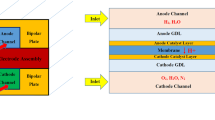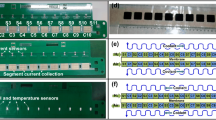Abstract
Local measurement of current was conducted using a segmented cell to understand local electrochemical characteristics of polymer electrolyte membrane fuel cell with counter flow channel under pressurized condition. We changed stoichiometry ratio (SR), relative humidity (RH), and operating temperature to examine the effect of operating parameters on the performance of fuel cell under pressurized condition. A segmented fuel cell with a divided active area of 25 cm2 was used to measure local current distribution to analyze complex relationships between SR, RH, temperature and pressure. The results show that RH and SR are the main factors for determining current distribution. High SR with low-RH reactants make the membrane of the inlet region more dried out, which leads to less electrochemical reaction. When SR is low, however, less water is evaporated and the effect of RH condition is minimized. On the other hand, current distribution at various RH and SR conditions at 3 bar is relatively similar among the results. Thus, the effects of RH and SR can be neglected for high operating pressure cases. When the temperature is high in pressurized condition, the Ohmic loss decreased and the overall cell performance improved.
Similar content being viewed by others
References
T. E. Springer, M. S. Wilson and S. Gottesfeld, Modeling and experimental diagnostics in polymer electrolyte fuel cells, Journal Electrochemical Society, 140 (12) (1993) 3513–3526.
J. Zhang, H. Li and J. Zhang, Effect of operating backpressure on pem fuel cell performance, ECS Transactions, 19 (31) (2009) 65–76.
J. Zhang, C. Song, J. Zhang, R. Baker and L. Zhang, Understanding the effects of backpressure on PEM fuel cell reactions and performance, Journal Electroanalytical Chemistry, 688 (2013) 130–136.
B. Wahdame, D. Candusso and J. M. Kauffmann, Study of gas pressure and flow rate influences on a 500W PEM fuel cell, thanks to the experimental design methodology, Journal Power Sources, 156 (2006) 92–99.
D. K. Kim, J. S. Koh, M. S. Kim and H. H. Song, Experimental and computational study on the dynamic interaction between load variation and back pressure control in a polymer electrolyte membrane fuel cell for automotive application, International Journal Hydrogen Energy, 40 (36) (2015) 12370–12381.
H. S. Kim, D. H. Lee, K. Min and M. Kim, Effects of key operating parameters on the efficiency of two types of PEM fuel cell systems (high-pressure and low-pressure operating) for automotive applications, Journal of Mechanical Science and Technology, 19 (2005) 1018–1026.
N. Rajalakshmi, M. Raja and K. S. Dhathathreyan, Evaluation of current distribution in a proton exchange membrane fuel cell by segmented cell approach, Journal of Power Sources, 112 (2002) 331–336.
G. Bender, M. S. Wilson and T. A. Zawodzinski, Further refinements in the segmented cell approach to diagnosing performance in polymer electrolyte fuel cells, Journal Power Sources, 123 (2003) 163–171.
A. Hakenjos and C. Hebling, Spatially resolved measurement of PEM fuel cells, Journal Power Sources, 145 (2005) 307–311.
A. Hakenjos, H. Muenter, U. Wittstadt and C. Hebling, A PEM fuel cell for combined measurement of current and temperature distribution, and flow field flooding, Journal Power Sources, 131 (2004) 213–216.
Y. G. Yoon, W. Y. Lee, T. H. Yang, G. G. Park and C. S. Kim, Current distribution in a single cell of PEMFC, Journal of Power Sources, 118 (2003) 193–199.
Q. Dong, M. M. Mench, S. Cleghorn and U. Beuscher, Distributed performance of polymer electrolyte fuel cells under low-humidity conditions, Journal Electrochemical Society, 152 (11) (2005) A2114–A2122.
M. M. Mench, Q. L. Dong and C. Y. Wang, In situ water distribution measurements in a polymer electrolyte fuel cell, Journal Power Sources, 124 (2003) 90–98.
Q. Dong, J. Kull and M. M. Mench, Real-time water distribution in a polymer electrolyte fuel cell, Journal Power Sources, 139 (2005) 106–114.
D. Gerteisen, N. Zamel, C. Sadeler, F. Geiger, V. Ludwig and C. Hebling, Effect of operating conditions on current density distribution and high frequency resistance in a segmented PEM fuel cell, International J Hydrogen Energy, 37 (2012) 7736–7744.
H. Nishikawa, R. Kurihara, S. Sukemori, T. Sugawara, H. Kobayasi, S. Abe, T. Aoki, Y. Ogami and A. Matsunaga, Measurements of humidity and current distribution in a PEFC, Journal Power Sources, 155 (2006) 213–218.
F. B. Weng, B. S. Jou, C. W. Li, A. Su and S. H. Chan, The effect of low humidity on the uniformity and stability of segmented PEM fuel cells, Journal Power Sources, 181 (2008) 251–258.
M. M. Mench, C. Y. Wang and M. Ishikawa, In situ current distribution measurements in polymer electrolyte fuel cells, Journal Electrochemical Society, 150 (8) (2003) A1052–A1059.
H. Sun, G. Zhang, L. Guo and H. Liu, A study of dynamic characteristics of PEM fuel cells by measuring local currents, International Journal Hydrogen Energy, 34 (2009) 5529–5536.
T. V. Reshetenko, G. Bende, K. Bethune and R. Rocheleau, Systematic study of back pressure and anode stoichiometry effects on spatial PEMFC performance distribution, Electrochimica Acta, 56 (2011) 8700–8710.
Z. Liu, Z. Mao, B. Wu, L. Wang and V. M. Schmidt, Current density distribution in PEFC, Journal Power Sources, 141 (2005) 205–210.
A. M. Abdullah, T. Okajima, A. M. Mohammad, F. Kitamura and T. Ohsaka, Temperature gradients measurements within a segmented H2/air PEM fuel cell, Journal Power Sources, 172 (2007) 209–214.
M. Noponen, T. Mennola, M. Mikkola, T. Hottinen and P. Lund, Measurement of current distribution in a free-breathing PEMFC, Journal Power Sources, 106 (2002) 304–312.
D. Natarajan and T. V. Nguyen, Effect of electrode configuration and electronic conductivity on current density distribution measurements in PEM fuel cells, Journal Power Sources, 135 (2004) 95–109.
R. Eckl, R. Grinzinger and W. Lehnert, Current distribution mapping in polymer electrolyte fuel cells-A finite element analysis of measurement uncertainty imposed by lateral currents, Journal Power Sources, 154 (2006) 171–179.
Y. S. Kim, D. K. Kim, I. M. Kong, M. S. Kim and M. S. Kim, Local electrochemical characteristics for various operating pressure and temperature using segmented polymer electrolyte membrane fuel cell, Journal of Mechanical Science and Technology, 30 (9) (2016) 4391–4396.
Ch. Wieser, A. Helmbold and E. Gülzow, A new technique for two-dimensional current distribution measurements in electrochemical cells, Journal Applied Electrochemistry, 30 (2000) 803–807.
P. K. Jithesh, T. Sundararajan and S. K. Das, Experimental investigation of dry feed operation in a polymer electrolyte membrane fuel cell, Journal Power Sources, 260 (2014) 243–250.
L. K. Kwac and H. G. Kim, Investigation of gas flow characteristics in proton exchange membrane fuel cell, Journal of Mechanical Science and Technology, 22 (2008) 1561–1567.
H. S. Kim and K. Min, An experimental investigation of temperature distribution and flooding phenomena of cathode flow fields in a proton exchange membrane (PEM) fuel cell, Journal of Mechanical Science and Technology, 28 (2014) 3837–3843.
Acknowledgments
This work was supported by the Institute of Advanced Machinery and Design (IAMD) and Institute of Engineering Research (IER) of Seoul National University. Support from the Brain Korea 21 Plus Project (F14SN02D1310) of the Ministry of Education is appreciated. This research is also supported by the Korea Institute of Energy Technology Evaluation and Planning (KETEP) and the Ministry of Trade, Industry & Energy (MOTIE) of the Republic of Korea (No.20163010140530, No. 20173010032150). Additional support by Basic Science Research Program through the National Research Foundation of Korea (NRF) funded by the Ministry of Science and ICT (2017R1C1B5076491, NRF-2019R1A2C2087893, NRF-2019 R1F1A1058036, and NRF-2019M3E6A1064705) is greatly appreciated. Lastly, this work was supported by the Industrial Strategic Technology Development Program (10082569, Development of design package and prototype for commercial 5kW class SOFC-Engine hybrid system) funded by the Ministry of Trade, Industry & Energy of the Republic of Korea.
Author information
Authors and Affiliations
Corresponding author
Additional information
Recommended by Editor Yong Tae Kang
Young Sang Kim obtained his B.S., M.S. and Ph.D. in Mechanical Engineering from Seoul National University, Seoul, South Korea. His research interests include thermodynamics and polymer electrolyte membrane fuel cell.
Dong Kyu Kim obtained his B.S., M.S. and Ph.D. in Mechanical Engineering from Seoul National University, Seoul, South Korea. His research interests include thermodynamics and polymer electrolyte membrane fuel cell, and fuel cell vehicle.
Kook Young Kim obtained his B.S. and M.S. in Mechanical Engineering from Han Yang University, Seoul, and Ph.D. in Mechanical Engineering from Korea Advanced Institute of Science and Technology (KAIST), Daejeon, South Korea. His research interests include thermodynamics and Solid oxide fuel cell, and hybrid system.
Min Soo Kim obtained his B.S., M.S. and Ph.D. in Mechanical Engineering from Seoul National University, Seoul, South Korea. He joined the Department of Mechanical Engineering of Seoul National University as an Associate Professor in 1994. His teaching and research interests include refrigeration, heat transfer, thermophysical property, fuel cell systems and fuel cell electric vehicles.
Rights and permissions
About this article
Cite this article
Kim, Y.S., Kim, D.K., Ahn, K.Y. et al. Parametric study on the local current distribution of polymer electrolyte membrane fuel cell with counter flow channel under pressurized condition. J Mech Sci Technol 34, 2189–2198 (2020). https://doi.org/10.1007/s12206-020-0440-9
Received:
Revised:
Accepted:
Published:
Issue Date:
DOI: https://doi.org/10.1007/s12206-020-0440-9




